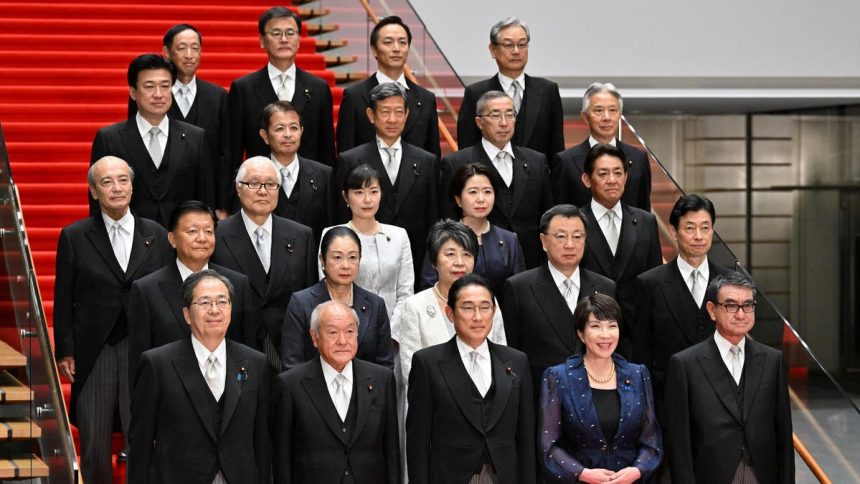The biggest surprise of Japanese Prime Minister Fumio Kishida’s latest cabinet reshuffle is his sudden embrace of “womenomics.”
For 20-plus years now, Japanese leaders have flirted with the idea of empowering the female half of the nation’s 126 million people. Economists everywhere, after all, agree that countries and companies that best utilize female talent are more productive, innovative and prosperous.
On the surface, this seemed to be Kishida’s strategy in naming five women to his cabinet last week, matching previous records. It was a clear U-turn. In his nearly 24 months in power, Kishida barely even mentioned gender equality.
Better late than never? Perhaps, until you consider what Kishida said about why he named five women to his latest cabinet. Kishida says he hopes his female draft picks will “make the most of their female sensibilities.”
Can you say “cringe?” For years now, Tokyo has been fending off accusations of tokenism. It’s a valid charge. Twenty-plus years ago, then-Prime Minister Junichiro Koizumi’s move to name a record five female cabinet members was more media stunt than substance.
Years later, his protégé Shinzo Abe would do the same in 2014. But just as with Koizumi’s government, Abe’s pledge to make women “shine” ended up being a perfunctory and symbolic effort to appear enlightened.
The numbers tell a very different story. A decade ago, Tokyo ranked 101st on the World Economic Forum’s gender parity tables. In 2023 it’s 125th, 20 places behind South Korea and 18 behind China, where gender parity in power is even less of a thing (the U.S. ranks 43rd).
You’d think all this backsliding would get Tokyo’s attention. Not quite, when you consider Kishida’s “female sensibilities” worldview. It suggests that for Kishida and his inner circle, empowering women is a public relations stunt.
In 2001, Koizumi was the first modern Japanese leader to talk about gender disparities in economic terms. That was fully 33 years after the 1986 passage of the Japanese Equal Employment Opportunity Law, which prohibited discrimination. Yet Koizumi, prime minister until 2006, gave his “assassins,” a group of telegenic women—including a former beauty queen—zero clout to influence policy in Tokyo.
A decade later, Abe played a similar game. His talk of championing women was part of his “Abenomics” plan to raise Japan’s innovative game. By prioritizing photo ops over concrete steps to increase the ratio of female managers, board members and Cabinet officials, Japan on Abe’s watch lost ground on global gender tables. Significant ground, too.
Abe’s replacement, Yoshihide Suga, barely mentioned womenomics in his year in the premiership. Nor had Kishida since taking over in October 2021.
This belated embrace of the idea that Japan must harness female talent is welcome, of course. But the message, if it really is a sincere one, has gotten lost in the intrigue surrounding Kishida’s latest reshuffling.
For Kishida’s Liberal Democratic Party, shaking up cabinets is a tried-and-true way to revive flatlining approval ratings. Kishida’s support is in the low 40s, at best. Yet Kishida dumped his best minister and retained the worst-performing ones. Surprisingly, Kishida fired Yoshimasa Hayashi, who was widely seen as his most talented minister.
It’s nice that Kishida named Yoko Kamikawa foreign minister. Only time will tell if a three-time justice minister with little foreign policy experience will survive longer than the two previous female holders of the job in the early 2020s. But the way Kishida discarded Hayashi for a diplomatic novice suggests he views foreign policy as his domain. Odds are, Kamikawa will have little latitude to think and act for herself.
Bizarrely, Kishida stuck with his woefully uninspiring economic team. How could any global investor be happy about Shunichi Suzuki staying on as finance minister, Yasutoshi Nishimura as industry minister or Sanae Takaichi as economic security minister?
In 714 days, this gang put zero notable reforms on the scoreboard. Nor has it telegraphed a plan to reduce bureaucracy, modernize labor markets, increase innovation, prod companies to share steady profits with workers or attract overseas talent.
Odd, too, that Kishida thinks investors driving the Nikkei Stock Average to 30-year highs are glad to see Taro Aso, who turns 82 on Wednesday, stay on as LDP vice president. This is not about age. Aso had two earlier opportunities—as prime minister from 2008 to 2009 and finance minister from 2012 to 2021—to build a more vibrant economy.
Aso failed at every turn. But thanks to Tokyo’s factional politics, he gets to stick around and stymie progress. These dynamics explain why long-serving party Secretary General Toshimitsu Motegi also gets another chance to grow his political fiefdom as economies around Asia grow their private sectors.
Don’t get me wrong: I’m happy to see Kishida appear to realize that Japan has a gender inequality problem. I’d be far more impressed, though, if he named a female finance minister, a female chief cabinet secretary and named women to at least half of 19 cabinet positions. Even better, if Kishida enacted incentives—or tax penalties— or companies championing the patriarchy over greater innovation and productivity.
If the WEF rankings plunge isn’t depressing enough, consider how Japan stands up versus other nations in terms of women in political power: behind Cambodia, Syria and even Saudi Arabia, according to the Geneva-based Inter-Parliamentary Union.
Bottom line, women are still being taken for granted in Japan. So is, by extension, the need for big economic disruption. In top-down Japan, if the government won’t change, corporate chieftains won’t either.
Read the full article here










